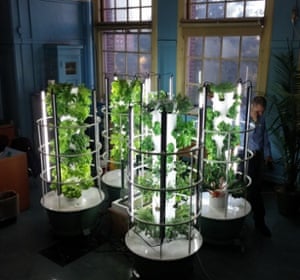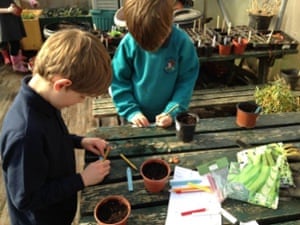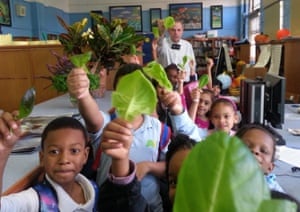
If you don’t have much outdoor space, you could always plant mini fruit such as ‘Ruby Beauty’ which flowers May to June. Photograph: Thompson & Morgan
T
here’s nothing more satisfying than harvesting your own crops at school. As the first plums of the season ripen on trees and tiny cabbages appear between leaves, students can feast both their eyes and their bellies, on the fruits of their labour.
But there are also a wide range of educational benefits to going green, from teaching about photosynthesis and the life of a plant to seasonal poetry and creative writing, the topic can be explored in a variety of classes.
If you’re interested in greening up your classroom or designing a wild space somewhere on the school grounds, there’s a lot to consider. Here’s our guide for getting started:
How to grow in the classroom
When growing plants indoors keep it simple and start small, according to teacher Stephen Ritz from Discovery high school.

Ritz, who is famed for his pioneering indoor farming project the edible classroom, recommends easy-to-grow crops such as lettuces, beans or peas, or growing your own classroom herb garden. These vegetables are the best choice and are easy to take care of. They can be grown in pots on windowsills where they can get plenty of sunlight and need regular water.
Cups and pots are great to grow in, says Ritz, but he also recommends the Tower Garden by Juice Plus – a vertical aeroponic growing system that lets you grow upwards, saving space.Beckie Taylor, a teacher from Manor primary school in Coseley, grows pumpkins which can be planted from April onwards in small disposable cups. They also need regular water and sunlight. Once they are large enough they can be moved to growbags outside.
To make sure your crops are tended to, Taylor suggests putting up a chart to keep track of what the plants need and when. “Children can mark off when they have been watered in order to avoid neglect or over watering,” says Taylor.
It’s also vital to make sure there’s someone to watch the plants over the holidays. Ritz plans ahead so things sprout during term time. However, if this doesn’t work out he says there’s nothing wrong with sending plants home for eager young gardeners to look after.
Taylor has some words of warning: “You will need to ensure the space chosen [to grow plants] is away from important work in the classroom, such as books and displays of work. It also may be hard to control the conditions needed in the classroom.”
Growing on the school grounds

First find a good growing spot. This isn’t always easy but by law schools must have suitable outdoor space for playing team games. “If schools are committed to growing vegetables then they are not going to mind losing bits of their sports field for veg beds,” says Mel Jacob, who works for the outdoor education companyPoppies & Parsnips.
If your school does lack space, Jacob recommends quick-crops such as carrots that can grow in old welly boots, buckets and containers.
She adds: “I think that schools can apply for allotments and the council can be supportive of this but they need to be close by to the school or else too much time is taken up walking to the allotment .”
Once you’ve got the land sorted, she says, you cannot be too precious about the growing bit. “It’s not going to look like Chelsea flower show; children tend not to plant in straight lines.”
Fruit is a good choice for outside growing, and berries of various kinds (strawberries and blueberries) grow well.
Felicity Plent, head of Education at Cambridge University Botanic Gardenrecommends a new dwarf raspberry from Thompson & Morgan called “Ruby Beauty” , which is suitable for growing in small spaces or a container and is likely to give crops before the end of the summer term.
Don’t worry too much about when to start planting because different vegetables grow at different times, says Jacob. Even when the growing season ends you can get active with things like minibeast hunts or making garden structures and Christmas wreaths with children in winter.
How to link gardening with learning

There’s lots of ways to link all this with the curriculum. With younger gardeners, key stage 1 and 2 English spoken language can be practised and vocabulary developed. “Encourage the use of adjectives to describe plants and objects around the garden, taste, sound, texture. Use of descriptive vocabulary as a class to create poems,” advises Plent.
She adds that you can use it in science class too, identifying living things and their habitats with primary students, getting your class to name a variety of plants and discuss simple food chains.
Gemma Cahill, a teacher at Blackburn Central high school, says that you can teach older students skills that can help their future job prospects.
Gemma Cahill, a teacher at Blackburn Central high school, says that you can teach older students skills that can help their future job prospects.
For example, you can teach about science, technology, engineering and maths (Stem) careers by getting your secondary class to run their own blind test of organic and non-organic foods to see if they can tell the difference between the two. Explore what it would be like to work as a product manager for a company growing herbs for major shops and supermarkets. Science & Plants has more information about this investigation here, and other resources for secondary students on their website.
Organisations that can help
If you’re looking for teaching resources to help you link growing with the curriculum, you can find useful resources for teachers on the Royal Horticultural society’s website. Garden Organic also has lots of useful resources and tips for getting started as does Food for Life. If you’re keen on using the topic in science class then check out Science and Plants for Schools.Lots of organisations offer free tools to help you get started. Get in touch withGrow Wild to get free wildflower seeds– they have currently run out but will have more in the autumn next year.The Woodland Trust also has a free school tree pack. Thompson & Morgan, one of the UK’s largest mail order seed and plant company have put together some top tips on getting the most from a small space.

No comments:
Post a Comment